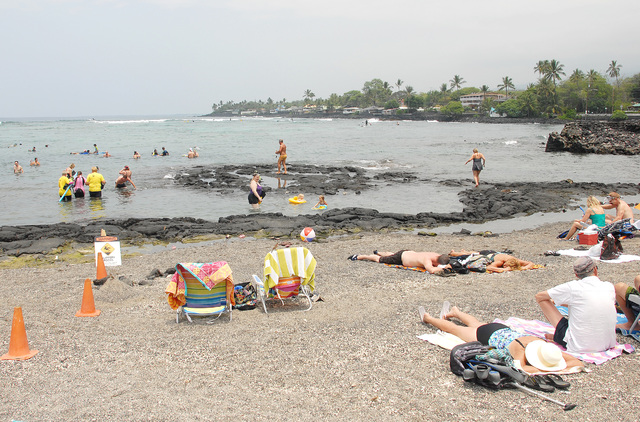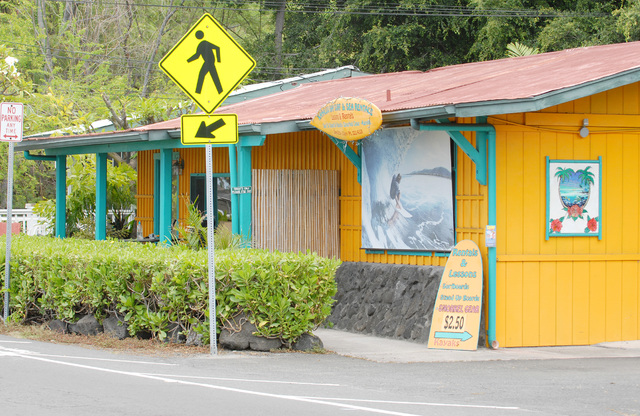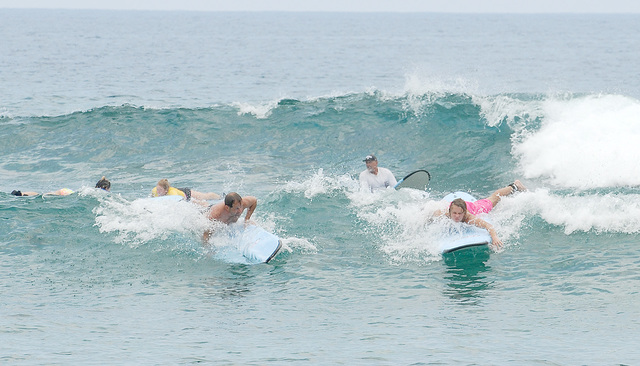New rules governing surf schools — plus other regulations to addressing overcrowding and conflicting uses — have resurfaced at Kahaluu Bay. ADVERTISING New rules governing surf schools — plus other regulations to addressing overcrowding and conflicting uses — have resurfaced
New rules governing surf schools — plus other regulations to addressing overcrowding and conflicting uses — have resurfaced at Kahaluu Bay.
This time, hopefully they have teeth, some surf instructors say.
The number of schools permitted to use the popular surf instruction spot on Alii Drive would be limited to four, with no more than eight students per school allowed in the water at any one time, under a set of rules being proposed by the state Department of Land and Natural Resources. Additionally, the bay would be divided into two zones, with swimming and snorkeling in the area south of Pyramid Rock and the lifeguard station, and surfing activities limited to areas to the north of those points. The rules also require surf instructors to obtain an advanced life saving certificate.
Complaints about illegal surf schools using the waves and parking areas at Kahaluu have simmered for a long time. Rick Green, owner of Hawaii Lifeguard Surf Instructors, said he’s fought for years to try to get the county and state to do something about it. He applauded the rules package but salted his approval with some deep skepticism.
“I’ve been spinning my wheels down there for 15 years,” he said. “I’ll listen to any process. But if you don’t enforce the rules that are already there, how are you going to enforce these new ones?”
“It’s all about safety, responsibility and control,” he said.
All schools should be held to the same standards for insurance, taxes and safety training, Green said.
Ed Underwood, administrator of the state’s Division of Boat and Ocean Recreation, said the proposal and the limit of four schools follows the recommendations of a working group comprised of state and county officials and ocean users.
The county and state have been looking at regulating surf schools at Kahaluu since at least 2007. Surf instructor Ben Callaghan has watched the waves become overcrowded as eight or more surf schools bring their customers to the spot.
“It’s a safety issue,” said Callaghan, co-owner of Kahaluu Bay Surf and Sea. “There’s a lot of people out here.”
Maria Robben, a boating legal fellow with DOBOR, who helped draft the rules, said the new activity zones shirk the swim area and more clearly show the areas surfers need to avoid.
Kahaluu users have self-regulated fairly well in the absence of clear boundaries, Callaghan said. Lifeguards have placed buoys to delineate surf areas and keep unwary snorkelers and swimmers away from the boards, he said.
“Everyone works together here,” he said.
That said, the rules make sense, he believes.
“This industry is starting to grow,” he said. “Most of the surf schools use this bay. From the state or county viewpoint, it’s a liability issue.”
Callaghan said he thought the limit of four schools was too low, however. Green called it a starting point.
“We could have 10 schools working out of Kahaluu as long as they are permitted, legal and restricted as far as the time of day they operate,” Green said.
Parks officials support the proposed rules, said Jason Armstrong, spokesman for the Hawaii County Parks and Recreation Department.
“We worked with the state on this and they came up with this proposal,” Armstrong said.
The public will have an opportunity to weigh in on the plan at a public hearing from 6 to 8 p.m. April 29 at the Kealakehe High School cafeteria.
All surf, kayak, and other tour operations that use the state’s waters are required to have a permit under rules that went into effect last fall, Underwood noted. Next up for scrutiny are the popular manta ray night dive operations. In coming months, DLNR will be bringing stakeholders to the table to hash out issues of safety, business concerns and conservation of the species, Underwood said.
“It’s going to be a tough one, because it’s such a huge business,” he said.
Robben said the industry has self-regulated well, but the species is a protected one, the sites are small and overcrowded and DOBOR is mandated to address those issues as well as safety concerns.
Work is just beginning on the regulatory process, Robben said.
“It’s such a huge revenue business,” she said. “It is tempting to just come in and start a business.”
Kahaluu proposed rules can be viewed at dlnr.hawaii.gov/dobor/draft-rules.





